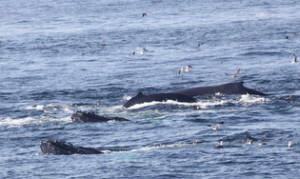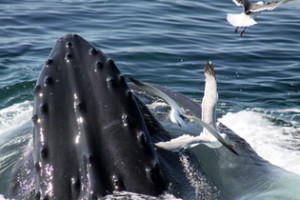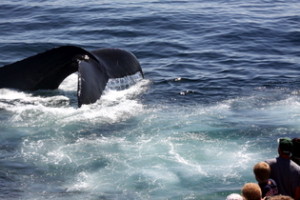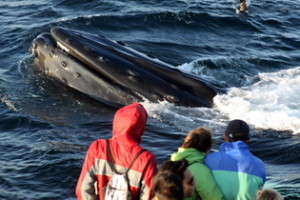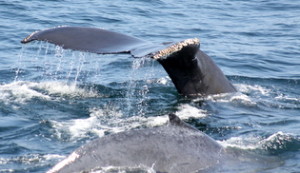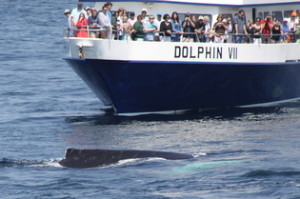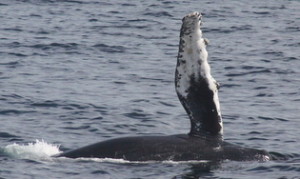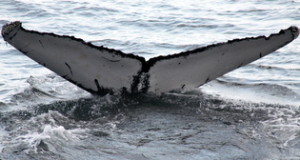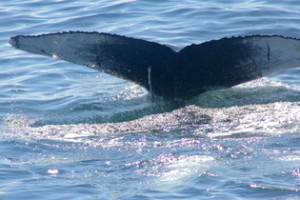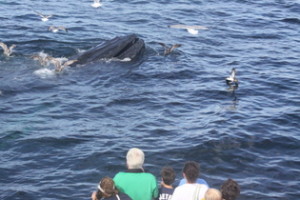July 30 to August 5
July 30th was bright and sunny and we headed east of Stellwagen Bank, where humpback whales have been congregating for the past few weeks. In the morning, we had wonderful close boat approaches from Banyon, a humpback born in 1998, as well as Wizard and her calf. Wizard is 21 years old and this is her sixth calf. So far this year, 26 different humpback mother and calf pairs have been identified in Stellwagen Bank and surrounding areas.
In the afternoon, the humpbacks began to feed, and what a show it was! We had groups of between 5 and 11 humpbacks cooperatively blowing huge rings of bubbles and then lunging at the surface. Dome, Cajun, Reflection, Tear, Palette, Lavalier, Ember and Alphorn were all seen among the pack.
Humpbacks may feed alone or in groups, but the bubble net feeding behavior that we have seen so frequently here in the past few weeks is most often accomplished with at least two different individuals. They blow air from their blow holes to create a spiral net of bubbles which trap and confuse fish. Sometimes, however, a lurking humpback will wait until the others have done all the work and will try to reap the benefits of the net without contributing anything in return!
In addition to the whales, the birds were also taking advantage of the rich food source of Stellwagen Bank. Five parasitic jaegers were spotted over the course of the day. These gull-sized birds often engage in kleptoparasitic behavior, harassing terns and other small birds until they drop fish they’ve caught so that they can steal them!
After a mellow morning, the feeding picked up again on the afternoon of July 31st. By mid-day, 25-30 humpbacks had gathered off the eastern edge of Stellwagen Bank and were feeding voraciously on big schools of sand lance. Some humpbacks would feed as part of a group, while others would kick feed on their own, using their enormous tails to stun their prey.
After taking in huge mouthfuls of food and water, these humpbacks would engage in a behavior called dragging. Here, they swim with their heads out of the water using their forward momentum to drain the salt water between their baleen plates as their food gets trapped in the bristles on the inside edge of their baleen.
Just in time for Provincetown’s family week, we had a “family” moment out on Stellwagen Bank as we saw Salt and Etch-a- Sketch in the same feeding group. Etch-a-Sketch is Salt’s grand-calf. Etch-a-Sketch was born in 1998 to Thalassa, who in turn was Salt’s calf in 1985. Calves tend to return to the same feeding ground that their mothers bring them to in their first year of life, so we now see many generations of whales coming back to the same spot year after year!
Etch-a-Sketch
On August 1st, we couldn’t believe our good luck, as dozens of humpback whales spent the afternoon breaching. Most of the time, we’re lucky to get a breach a day, but these whales ushered in the new month with a series of spectacular aerial behavior throughout the day. We began the morning with humpbacks spread out across the horizon. Everywhere we looked, spouts dotted the horizon. Suddenly, about a half a mile to the north of the Dolphin VII, 6 humpbacks breached all in a row!
The action continued into the afternoon when Circuit, a female first seen in 1999, was spotted lobtailing. After spending several minutes repeatedly smacking her tail on the surface of the water, she tail breached once, swam under the boat, and then did it again on the other side, giving passengers on both the port and starboard decks an amazing look!
After this whale swam away, we steamed toward more activity to the north. An unknown calf was lobtailing furiously at the surface. When we see calves engaging in this type of behavior, we suspect that they may be doing so to imitate adults, or to get the attention of their mother. We thought it was the latter case when a larger whale popped up next to the calf a few minutes later; however, rather than the whale’s mother, it turned out to be Joy, a 6 year old humpback whom we know to be without a calf this year. Eventually, mom appeared, and she turned out to be a 26 year old named Tau. This is Tau’s second calf.
Despite the increasing winds, the storm predicted for the evening never arrived. However, the increasingly rough seas seemed to keep our whales riled up, and the breaching continued into the evening. Up to ten whales were seen breaching at a time on our evening’s trip. Many of our naturalists exclaimed that it was probably the most acrobatic activity that they had seen in a given day!
Breaching and flipper slapping continued into August 2nd. All morning, we had close up looks at very active humpbacks, including Hancock and Tear.
The Dolphin VIII witnessed non-stop breaching and flipper slapping from Alphorn and Pele. Meanwhile, aboard the Dolphin X, Colt flipper slapped for such a long time that his pectoral flippers started to bleed! No one knows exactly what this flipper slapping behavior means, but researchers suspect that it has some social function as it often precedes the formation or dissolution of groups.
In the middle of the day, the whales took a break in order to feed, and dozens of humpbacks, including Aerospace, Liner, Milkweed, and Belly were seen with wide open mouths, lunging through schools of fish.
Also in the crowd of humpbacks was a whale named Ember, a male born in 1982. On our way back home, we were delighted to meet a little girl on the boat who was also named Ember. She was amazed and delighted that the first whale she ever saw shared her unusual name!
The real drama came in the evening, as a passing storm churned up the seas and excited the whales as well. With lightning visible on the horizon, we watched Putter breach over 40 times before we turned around and headed for home.
On August 3rd, the humpbacks spent a mellow morning slowly traveling in small groups. Snare and Pitcher were in close association with one another, and we noted with interest that these juvenile whales were both born in 2007. Humpbacks tend to become more likely to associate with one another as they get older. After a few years of solitary youth, these humpbacks become more social as they age!
Like the previous few days, the afternoon seemed to the be the time when the combination of tides and currents brought the food to the surface, and the feeding commenced again. Big aggregations of hungry baleen whales included three different species: humpbacks, Minkes, and even a single fin whale! Humpbacks not seen yet this year, including Scratch and Walrus came together to blow huge, spiraling nets of bubbles in order to entrap their prey.
In the midst of all of this excitement, one of our eagle-eyed naturalists observed that one of our humpbacks, Shuffleboard, had a lamprey attached to its fluke! These parasitic fish occasionally will attach to the bodies of whales to get a meal of blood as they adhere to the whales’s skin using a suction cup-like mouth. In the photo below, notice the lamprey dangling from Shuffleboard’s left fluke.
As windy weather persisted into August 4th, so did the breaching humpbacks. On the morning trip, Centipede, a humpback first seen in the year 2000 was breaching repeatedly, displaying the beautiful distinct markings on its flippers with every jump.
The afternoon took a dramatic turn when we discovered that Ganesh, a 13 year old humpback who is here with her new calf, is entangled in fishing gear. Additionally, we noted that her calf had fresh propeller wounds across its back. This was a sad reminder of the two leading causes of injury and mortality to large whales in the North Atlantic. We promptly called the disentanglement team at the Provincetown Center for Coastal Studies who raced to the scene in their speedy research vessel, the Ibis. Unfortunately, the increasingly heavy seas made it difficult for them to thoroughly or assess or disentangle Ganesh, and we are keeping a sharp eye out on all of our whale watches in hopes that we will spot this whale again under more favorable sea conditions.
While all of this was going on aboard the Dolphin IX, birders aboard the Dolphin X were having a field day with all of the different types of terns spotted near the Provincetown beaches. Our expert birder naturalist identified Foster’s, as well as an occasional Royal tern flitting and diving just off of Wood End.
By August 5th, the wind had slacked, the seas had flattened, and the feeding frenzy had started up again. As one big group of humpbacks blew huge bubble nets around schools of sand lance, Venom’s calf imitated the adults and blew short bursts of bubbles on the periphery! On the second trip, Echo popped up off the port side of the Dolphin IX with a mouth so full you could see the fish squirming inside before they were swallowed whole!
Bird enthusiasts were excited to spot several parasitic and pomerine jaegers swooping among the flocks of terns and shearwaters, occasionally harassing them enough that they dropped their freshly caught fish!
Finally, this week we want to give a big thank you to our intern, Iliana, who is visiting this summer from the Dominican Republic. She has been assisting with research projects in the Silver Bank, an area off the coast of the Dominican Republics where our humpbacks often go to mate and give birth, and she is spending the summer learning about humpback whale behavior in their northern feeding grounds.






